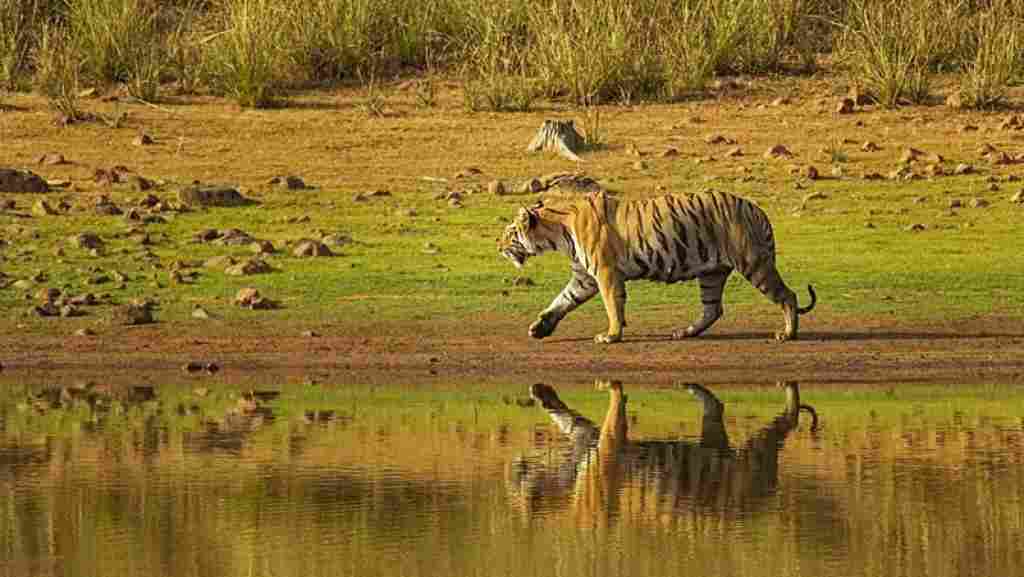Bor, an incredible wildlife sanctuary covering an area of 61 sq. Km, is an attractive weekend getaway. Bor Nature Reserve, located in the Wardha River Valley in the Wardha region of Maharashtra state, has received the status of a tiger reserve, making it the smallest reserve in the country. Reserve with an area of 138 sq. Km, which includes the Bor Wildlife Sanctuary, the New Bor Wildlife Sanctuary and an additional 16 sq. Km, is the sixth and 47th Maharashtra tiger reserve in the country.
Flora and Fauna in the Bor Wildlife Sanctuary
The Wildlife Institute of India (WII) estimates that there are 12 tigers living in and around the reserve, but the number has increased to 15, and 3 new cubs were found in March 2011.
It is home to wild animals such as tigers, panthers, monkeys, bears, and wild dogs. Its flora includes teak, Ainu, Tiandu and bamboo. You may also see leopards, bison, wild dogs and various deer, as well as a large number of birds.
The forest is mostly covered with dense teak forests and related plants. It is rich in various animal species. The main attractions are Indian pangolins, Indian wolves, wild dogs, jackals, sloth bears, striped hyenas, jungle cats, and wild boars, Gaur, deer and antelope. With the rich flora and fauna of the Satpura-Maikal landscape, Bor Tiger Reserve is home to many wild animals, such as the majestic Royal Bengal tiger, cheetah, barking deer, mouse deer, wild boar, Bearchital sloth, and sambar. Deer, Indian bison, blue bull, peacock, etc.
About Bor Wildlife Sanctuary
Bor Wildlife Sanctuary reserve can also be visited from Mumbai, as Nagpur is connected to the capital by air, road and rail. Sillari (closed on Wednesday; other gates closed on different days) is the most convenient gate to enter the forest from the Maharashtra side. It is connected to the highway that crosses the Wardha-Nagpur highway and you can reach the Bor Dam Visitor Center.
Bor and some adjacent protected areas will be merged with the Pench Tiger Sanctuary (Maharashtra) as the main satellite area, more than double the area of this well-known tiger reserve. Originally a wildlife sanctuary, Bor was declared a tiger sanctuary in 2014 and is the smallest protected area in the country with a population of four tigers.
This tiger sanctuary is centrally located between Pench Tiger Sanctuary to the northeast, Nagzira Navegaon Tiger Sanctuary to the northeast, Umred Karhandla Wildlife Sanctuary to the southeast, Tadoba-Andhari Tiger Sanctuary to the southeast, Melghat Tiger Sanctuary to the northwest and Satpura National Park and Tiger Sanctuary to the northwest.
Until 2011, there were 12 tigers in and around Bor, according to the Wildlife Institute of India. An estimated six to eight tigers live in the Bor and Novy Bor regions. According to the 2010-11 Tiger Assessment Report, 24 tigers live in the Pença and Bor landscape.
Also Read: Jaldapara Wildlife Sanctuary: Things to do, animals and how to reach
It’s a perfect place for Rejuvenation and connect with wildlife and nature
This biodiversity reserve is the perfect place to get away from the hustle and bustle of the city. Let nature provide you with all the freshness and tranquility in this beautiful place.
Bor is an ideal destination for nature lovers, bird watchers and tiger safaris. Apart from these places, near the Bor Wildlife Sanctuary in the Wardha region, it is best to visit the Gitai Mandir Temple and the Lakshmi Narayan Temple. The reserve extends over an area of 121 sq. Km, including the catchment area of the Borskaya dam.
Also Read : Rastriya Swachhta Diwas : commencement, Significance and progress
Government’s steps on preserving this Sanctuary:
After many challenges the reserve became the 47th tiger sanctuary in India and was declared a tiger sanctuary by the Minister of the Environment Prakash Javadekar on 7 July 2014 to support national conservation efforts.
He divided the sanctuary into two parts, east and west. Although the reservoir is not counted on the territory of the protected area, it is regarded as a special delineation in the protected area. This is the most protected and difficult-to-access part of the reserve because public access is forbidden. The buffer zone is a less protected forest area adjacent to the protected area and serves as a protective barrier for the central area.
The ecotourism zone, intended for public access to nature and wildlife, accounts for 4.3% of the total area of the reserve. A wildlife tourism promotion was planned in 2002 at the Bor Dam, on the outskirts of the Boor Wildlife Sanctuary, valued at Rs 6.2 million.
Since 2005, wildlife conservation NGO Srishti Parivartan Mandal, in collaboration with the Maharashtra Pinch Tiger Reserve Forestry Office, has worked on several conservation projects in Bor Reserve, including water conservation through small dams, habitat mapping, and orphan tiger cub’s rehabilitation.
The reserve needs more protection and habitat management, especially in the adjacent forested areas. The reserve needs more protection and habitat management, especially in the adjacent forested areas.
There are currently no such master plans for any protected area in Maharashtra. A final AIA declaration, intended to be used as a buffer zone to reduce development pressures around the protected area, was expected for several years.
Also Read : Maina Pakshi : Interesting facts about this famous bird from the beloved game ‘chidiya udd’
